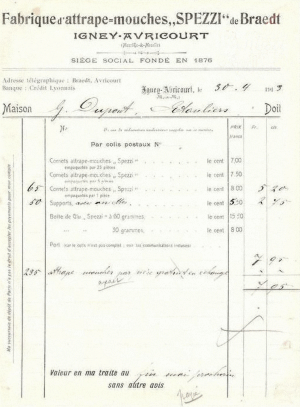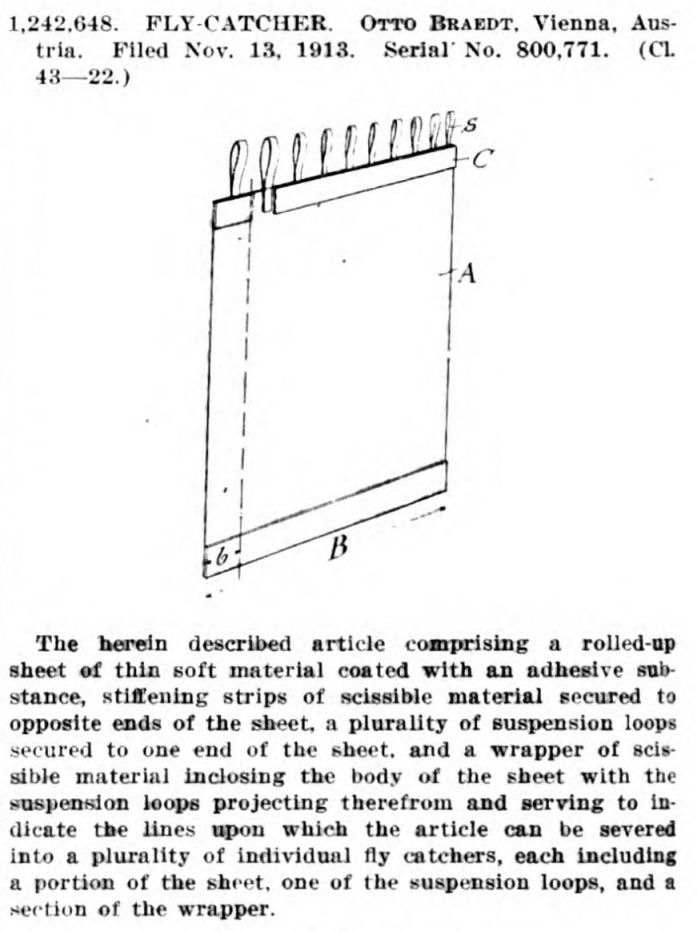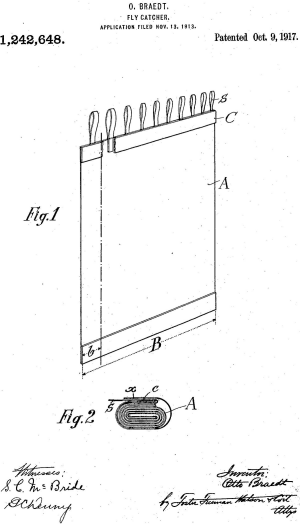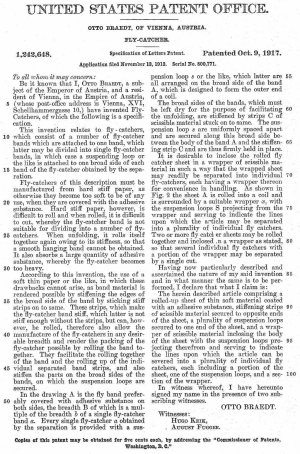|
|
|
|
|
|
|
1913 - L'attrape-mouches
d'Igney-Avricourt
|
Voici un curieux document de 1913, signalant une fabrique d'attrape-mouches
à Igney-Avricourt.
Mythe ou réalité ?
Une des seules traces que l'on retrouve en ce lieu est dans le
Weltadressbuch der chemischen de 1915 ou est signalé :
« Otto Braedt in Deutsch-Avricourt (Lothringen) »
On constate en premier lieu que l'entreprise s'est alors
domiciliée dans la partie allemande, ce qui s'explique par les
informations suivantes :
Est-Républicain - 20 août 1915 : « Mise sous séquestre de biens
appartenant â des sujets allemands
[...] Braedt, à Igney-Avricourt. Allemand. » |
 |
Journal de la Meurthe et des Vosges 19 août 1915 :
« Les biens
allemands
Extrait des ordonnances de mises sous séquestres de biens
appartenant à des Allemands, rendues en avril 1915 par la Cour
de Nancy (« Officiel » du 15 août) :
[...] Séquestre de sommes et valeurs en dépôt dans une banque :
Volpelius, propriétaire à Sulzbach ; Braedt, à Igney-Avricourt » |
Pour retrouver cet Otto Braedt, il faut se pencher sur les
différents dépôts de brevets
Au Bulletin des lois de la République française :
« 388114. Brevet de quinze ans, 13 mars 1908 : Braedt (O.),
représenté par Frey, à Paris, boulevard Beaumarchais, n° 2 -
Attrape-mouches »
et on trouve aussi en France : « 465313 - Attrape-mouches, 25
novembre 1913, (publication 14 avril 1914), Braedt Otto »
Au Moniteur belge de 1914 :
« Brevet 261832 - Braedt (O.), représenté par E. et G. Bede
Vienne (Autriche), Schellhammergasse
Bruxelles, 8 nov. 1913
Attrape-mouches »
Et au Royaume-Uni
« 26,806. Braedt, O. Nov. 21. Adhesive traps. - In an adhesive -
band flytrap in which the width B of the band A is a multiple of
the width b of the band a, actually used, the band is made of a
soft and thin paper and the ends of the band are stiffened by
strips C. Suspensory loops s formed of flat strips are arranged
between the edge of the band and the strip C so as to project
centrally therefrom.
191326806 (A), 21 november 1913 Publication Date January 15,
1914 »
Pour le marché français, on voit aussi que si les dépôts de
brevet sont tardifs, le fabriquant recherchait des commerciaux
depuis plusieurs années :
Le Matin - 28 juin 1909 : « ON CHERCHE UN REPRESENTANT en
gobe-mouches pour la France; bonnes conditions. Otto Braedt, à
Hambourg, 23 (Allemagne). »
Journal des débats politiques et littéraires - 3 décembre 1909 :
« REPRESENTANTS CAPABLES
sont demandés par fabrique d'attrape-mouches.
OTTO BRAEDT
Hambourg 23 »
Le Matin - 27 janvier 1910 : « Représentants bien introduits
sont demandés contre conditions avantageuses par la fabrique
d'attrape-mouches Otto Braedt, Hambourg, 23 »
A cette date donc, la fabrique est à Hambourg. Rien ne prouve
cependant qu'elle date de 1876 comme le laisse supposer le
papier à entête ci-dessus, et on voit même les brevets allemands
déposés en 1908 seulement :
Patentblatt : herausgegeben von dem Kaiserl. 1908 : « 45k. 998
889. Aus Papier o. dal. hergeftellter aufklappbarer
Fliegenfangschirm. Otto Braedt. Hamburg. Schmalenbeckerstr. 10.
18.4.08. B. 38024. »
Il semble donc bien que Otto Braedt de Hambourg ait oeuvré à
vendre en premier ses produits en France dès 1908, puis
à s'implanter en France, en Belgique et au Royaume-Uni à compter
de 1913.
Il usurpe pour ce faire l'appellation « siège social fondé en
1876 » et ne dispose sans doute à Igney-Avricourt que d'un
bureau en douane (il n'y a ainsi aucune trace de fabrique ni d'employés
dans le recensement de 1911, tant à Igney qu'à Avricourt). Avec
la guerre, le marché est interrompu et les avoirs issus des
paiements en France sont bloqués.
Mais Otto Braedt persiste sans son commerce d'attrape-mouches.
Désormais installé à Vienne, il dépose des brevets aux
Etats-Unis, malgré leur entrée en guerre (6 avril 1917).
L'avantage de ces brevets est de nous donner un descriptif et
une illustration de son « attrape-mouches ».
Nous n'avons pas retrouvé de traces ultérieures de l'entreprise
et de son entrepreneur, mais il semble démontré que la fabrique
d'attrape-mouches à Igney-Avricourt n'est malheureusement qu'un mythe.
|
|
|
|
Official gazette of the United States Patent Office. 9 Oct.
1917.

1,242.648. FLY-CATCHER, OTTO BRAEDT. Vienna, Austria. Filed Nov.
13, 1913. Serial No. 800,771. (Cl. 43-22.)
The herein described article comprising a rolled-up sheet of
thin soft material coated with an adhesive substance, stiffening
strips of scissible material secured to opposite ends of the
sheet, a plurality of suspension loops secured to one end of the
sheet, and a wrapper of scissible material inclosing the body of
the sheet with the suspension loops projecting therefrom and
serving to indicate the lines upon which the article can be
severed into a plurality of individual fly catchers, each
including a portion of the sheet, one of the suspension loops,
and a section of the wrapper.
O. BRAEDT.
FLY-CATCHER.
Patented Oct. 9, 1917.
Application filed November 13, 1913. Serial No. 800,771. I
To all whom it may concern.
Be it known that I, Otto BRAEDT, a subject of the Emperor of
Austria, and a resident of Vienna, in the Empire of Austria, (whose
post-office address is Vienna, XVI, Schellhammergasse 10,) have
invented Fly- Catchers, of which the following is a
specification.
This invention relates to fly catchers, which consist of a
number of fly-catcher bands which are attached to one band,
which latter may be divided into single fly-catcher bands, in
which case a suspending loop or the like is attached to one
broad side of each band of the fly-catcher obtained by the
separation.
Fly-catchers of this description must be manufactured from hard
stiff paper, as otherwise they become too soft to be of any use,
when they are covered with the adhesive. Hard stiff paper,
however, is difficult to roll and when rolled, it is difficult
to cut, whereby the fly-catcher band is not suitable for
dividing into a number of flycatchers. When unfolding, it rolls
itself together again owing to its stiffness, so that a smooth
hanging band cannot be obtained. It also absorbs a large
quantity of adhesive substance, whereby the fly-catcher becomes
too heavy.
According to this invention, the use of a soft thin paper or the
like, in which these drawbacks cannot arise, as band material is
rendered possible by stiffening the edges of the broad side of
the band by sticking stiff strips on to same. These strips,
which make the fly-catcher band stiff, which latter is not stiff
enough without the strips, but can, however, be rolled,
therefore also allow the manufacture of the fly-catchers in any
desirable breadth and render the packing of the fly-catcher
possible by rolling the band together. They facilitate the
rolling together of the band and the rolling up of the
individual separated band strips, and also stiffen the parts on
the broad sides of the bands, on which the suspension loops are
secured.
In the drawing A is the fly band preferably covered with
adhesive substance on both sides, the breadth B of which is a
multiple of the breadth b of a single fly-catcher band a. Every
single fly-catcher or, obtained by the separation is provided
with a suspension loop s or the like, which latter are all
arranged on the broadside of the band A, which is designed to
form the outer end 1 of a coil.
The broad sides of the bands, which must be left dry for the
purpose of facilitating the unfolding, are stiffened by strips C
of scissible material stuck on to same. The suspension loop a
are uniformly spaced apart and are secured along this broad side
between the body of the band A and the stiffening strip C and
are thus firmly held in place.
It is desirable to inclose the rolled fly catcher sheet in a
wrapper of scissible material in such a way that the wrapped
sheet may readily be separated into individual fly-catchers,
each having a wrapper thereon for convenience in handling. As
shown in Fig. 2 the sheet A is rolled into a coil and is
surrounded by a suitable wrapper x, with the suspension loops S
projecting from the wrapper and serving to indicate the lines
upon which the article may be separated into a plurality of
individual ?y catchers. Two or more fly catcher sheets may be
rolled together and inclosed in a wrapper as stated, so that
several individual fly catchers with a portion of the wrapper
may be separated by a single cut.
Having now particularly described and ascertained the nature of
my said invention and in what manner the same is to be performed,
I declare that what I claim is:
The herein described article comprising a rolled-up sheet of
thin soft material coated with an adhesive substance, stiffening
strips of scissible material secured to opposite ends of the
sheet, a plurality of suspension loops secured to one end of the
sheet, and a wrapper of scissible material inclosing the body of
the sheet with the suspension loops projecting therefrom and
serving to indicate the lines upon which the article can be
severed into a plurality of individual fiy catchers, each
including a portion of the sheet, one of the suspension loops,
and a section of the wrapper.
In witness whereof, I have hereunto signed my name in the
presence of two subscribing witnesses.
OTTO BRAEDT.
Witnesses:
HUGO KEIK
AUGUST FUGGER.
 |
 |
|










